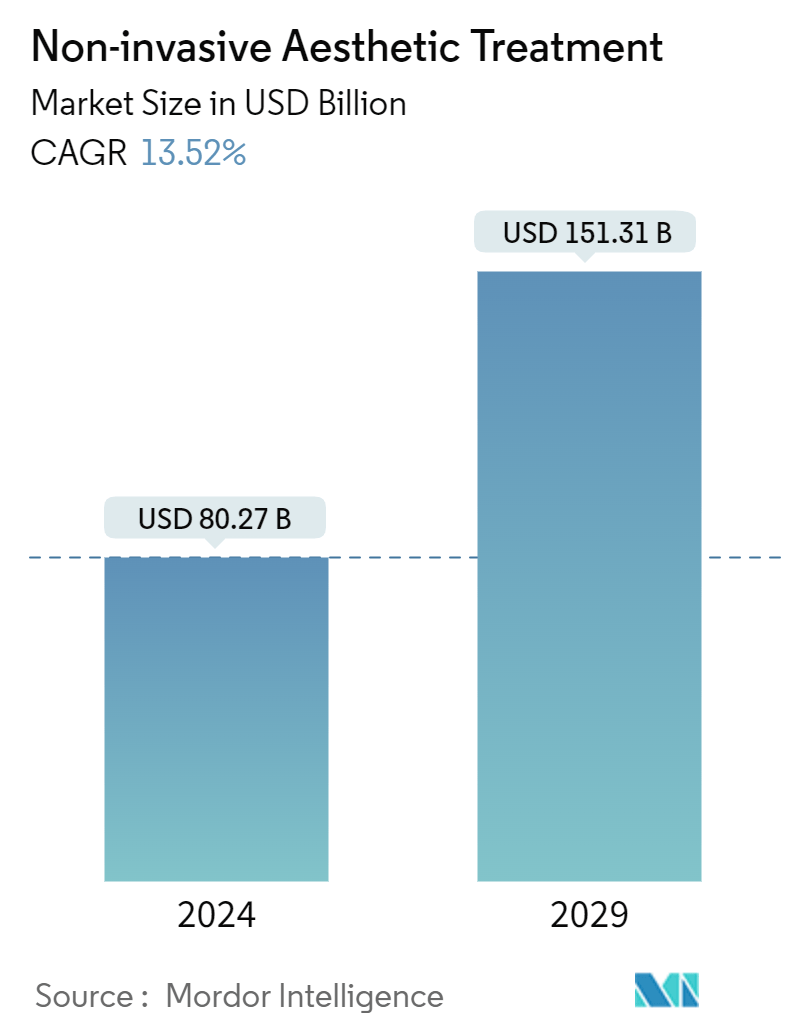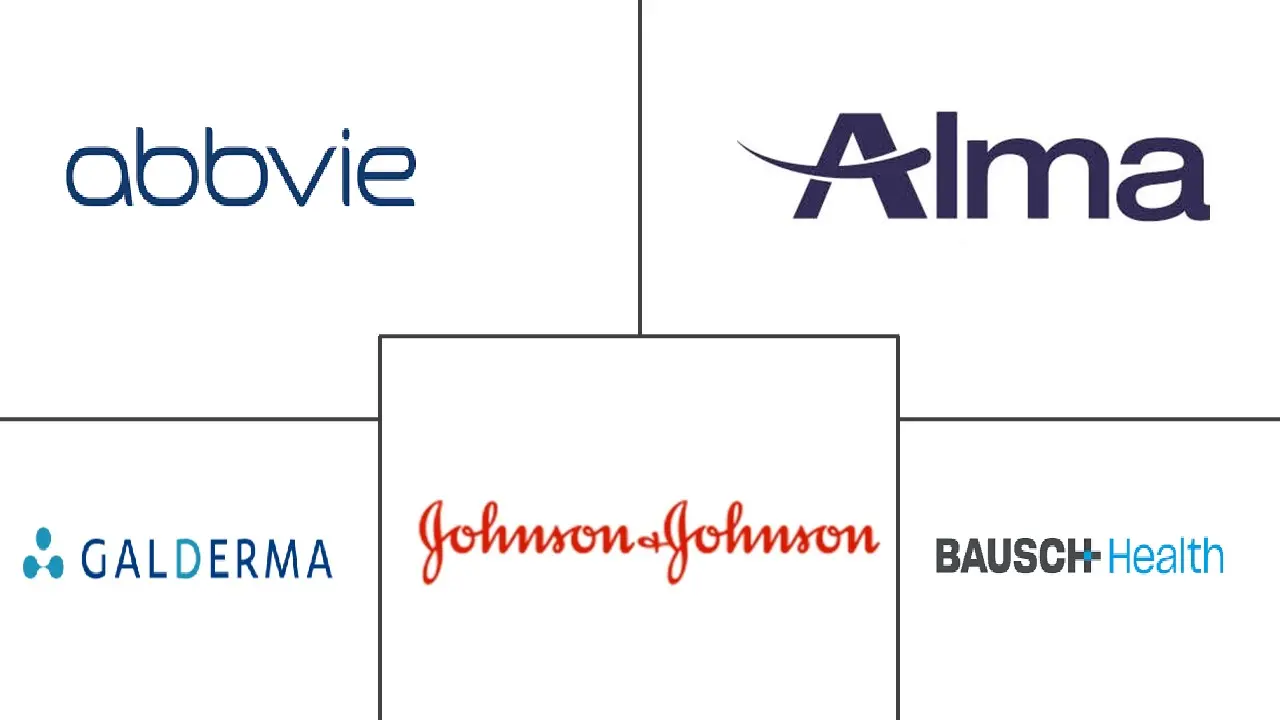Market Size of Non-invasive Aesthetic Treatment

| Study Period | 2019 - 2029 |
| Market Size (2024) | USD 80.27 Billion |
| Market Size (2029) | USD 151.31 Billion |
| CAGR (2024 - 2029) | 13.52 % |
| Fastest Growing Market | Asia-Pacific |
| Largest Market | North America |
Major Players
*Disclaimer: Major Players sorted in no particular order |
Non-invasive Aesthetic Treatment Market Analysis
The Non-invasive Aesthetic Treatment Market size is estimated at USD 80.27 billion in 2024, and is expected to reach USD 151.31 billion by 2029, growing at a CAGR of 13.52% during the forecast period (2024-2029).
The COVID-19 pandemic impacted the non-invasive aesthetic treatment market negatively, as the world went into quick lockdown to stop the spread of the infection due to the virus. The footfall of the people seeking aesthetics treatment is reduced at hospitals, clinics, and other places, which offer these services. Additionally, the scheduled procedures were either canceled or postponed, which impacted the market. For instance, as per the survey conducted in March 2020 by Hamilton Fraser Cosmetics Insurance in the United Kingdom on over 1,360 cosmetics practitioners, about 99.8% of practitioners stated that their practice had been affected by the ongoing COVID-19 pandemic. Moreover, the COVID-19 pandemic provided an opportunity to the companies to enhance their homecare non-invasive aesthetics products and services, as in the later phase of the pandemic, it was observed that there was an increase in the number of people seeking aesthetic treatments due to the work from a home scenario. which may augment the market growth in coming years.
As the digital world is moving forward with so many social media and other applications, the demand for beauty products has risen sharply in the last few years, as well as the increase in the demand for non-invasive aesthetic treatment procedures for beauty enhancement, which is the major driving factor behind the high growth rate of the market studied. Over the year, the popularity of non-invasive aesthetic treatment methods gained traction because they involve scarless and quick treatment procedures compared to other beauty enhancement procedures. For instance, as per the 2020 report of the American Society of Plastic Surgeons, the total minimally invasive cosmetic procedures conducted in the United States in 2020 was about 13,281,235, of which botulinum toxin type procedure were 4,401,536.
Other factors that may complement the growth of the non-invasive aesthetic treatment market during the forecast period are the technological advancement and launch of new products in the area, and its awareness in the old age people, which represent a fair share of the world population. For instance, in August 2020, Lumenis Ltd launched a new device for non-invasive treatment devices for personalized non-invasive radiofrequency (RF) treatments. According to the requirement of every patient, the device is called NuEra Tight.
The availability of low-cost beauty products in the market and complications and risks associated with the aesthetic treatment methods are the major restraining factors for the non-invasive aesthetic treatment market, as the other beauty products are cheap and readily available as compared to specialized non-invasive treatments, while the risks associated with the procedures create fear and misconceptions among potential users.
Non-invasive Aesthetic Treatment Industry Segmentation
As per the scope of the report, the non-invasive aesthetic treatment procedures are those which do not require cutting of skin or insertion of any instrument in the body for different beauty enhancement procedures. Non-invasive procedures are considered safe, painless, and require less recovery time than invasive treatment procedures. The global non-invasive aesthetic treatment market is segmented by procedures (injectables, skin rejuvenation, non-surgical fat removal, sclerotherapy, and other procedures), end users (hospitals, clinics, and medical spa), and geography (North America, Europe, Asia Pacific, Middle-East and Africa, and South America).
| By Procedures | |
| Injectable | |
| Skin Rejuvanation | |
| Non-surgical Fat Removal | |
| Sclerotherapy | |
| Other Procedures |
| By End Users | |
| Hospitals | |
| Clinics | |
| Medical Spa |
| By Geography | ||||||||
| ||||||||
| ||||||||
| ||||||||
| ||||||||
|
Non-invasive Aesthetic Treatment Size Summary
The non-invasive aesthetic treatment market is poised for significant growth, driven by increasing demand for beauty enhancement procedures and advancements in technology. The market, which experienced a downturn due to the COVID-19 pandemic, is rebounding as consumers seek quick and scarless beauty solutions. The rise of social media and digital platforms has further fueled interest in non-invasive treatments, making them a popular choice among consumers. The market is characterized by the introduction of innovative products and procedures, such as personalized radiofrequency treatments and new injectable solutions, which are expected to enhance market dynamics. Despite challenges like the availability of low-cost beauty products and associated risks, the market continues to expand, with injectables like botulinum toxin leading the way in popularity and usage.
North America is anticipated to maintain its dominance in the non-invasive aesthetic treatment market, with the United States at the forefront due to its positive perception of cosmetic procedures and the presence of key industry players. The region's growth is supported by a robust demand for beauty-enhancing procedures and the availability of advanced treatment options. The competitive landscape is intensifying, with numerous companies vying for market share through strategic acquisitions and product launches. This competitive environment, coupled with the ongoing development of new technologies and treatments, is expected to drive the market's expansion, making non-invasive aesthetic treatments increasingly accessible and appealing to a broader audience.
Non-invasive Aesthetic Treatment Market Size - Table of Contents
-
1. MARKET DYNAMICS
-
1.1 Market Overview
-
1.2 Market Drivers
-
1.2.1 Rise in Demand for Non-invasive Aesthetic Treatment Procedures
-
1.2.2 Technological Advancements
-
-
1.3 Market Restraints
-
1.3.1 Availability of Other Low Cost Beauty Product
-
1.3.2 Associated Complications and Clinical Risks
-
-
1.4 Industry Attractiveness - Porter's Five Forces Analysis
-
1.4.1 Bargaining Power of Buyers/Consumers
-
1.4.2 Bargaining Power of Suppliers
-
1.4.3 Threat of New Entrants
-
1.4.4 Threat of Substitute Products
-
1.4.5 Intensity of Competitive Rivalry
-
-
-
2. MARKET SEGMENTATION
-
2.1 By Procedures
-
2.1.1 Injectable
-
2.1.2 Skin Rejuvanation
-
2.1.3 Non-surgical Fat Removal
-
2.1.4 Sclerotherapy
-
2.1.5 Other Procedures
-
-
2.2 By End Users
-
2.2.1 Hospitals
-
2.2.2 Clinics
-
2.2.3 Medical Spa
-
-
2.3 By Geography
-
2.3.1 North America
-
2.3.1.1 United States
-
2.3.1.2 Canada
-
2.3.1.3 Mexico
-
-
2.3.2 Europe
-
2.3.2.1 Germany
-
2.3.2.2 United Kingdom
-
2.3.2.3 France
-
2.3.2.4 Italy
-
2.3.2.5 Spain
-
2.3.2.6 Rest of Europe
-
-
2.3.3 Asia Pacific
-
2.3.3.1 China
-
2.3.3.2 Japan
-
2.3.3.3 India
-
2.3.3.4 Australia
-
2.3.3.5 South Korea
-
2.3.3.6 Rest of Asia Pacific
-
-
2.3.4 Middle-East and Africa
-
2.3.4.1 GCC
-
2.3.4.2 South Africa
-
2.3.4.3 Rest of Middle-East and Africa
-
-
2.3.5 South America
-
2.3.5.1 Brazil
-
2.3.5.2 Argentina
-
2.3.5.3 Rest of South America
-
-
-
Non-invasive Aesthetic Treatment Market Size FAQs
How big is the Non-invasive Aesthetic Treatment Market?
The Non-invasive Aesthetic Treatment Market size is expected to reach USD 80.27 billion in 2024 and grow at a CAGR of 13.52% to reach USD 151.31 billion by 2029.
What is the current Non-invasive Aesthetic Treatment Market size?
In 2024, the Non-invasive Aesthetic Treatment Market size is expected to reach USD 80.27 billion.

